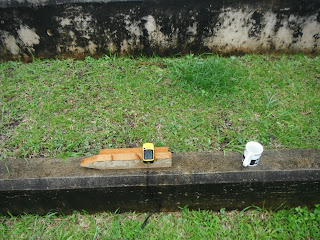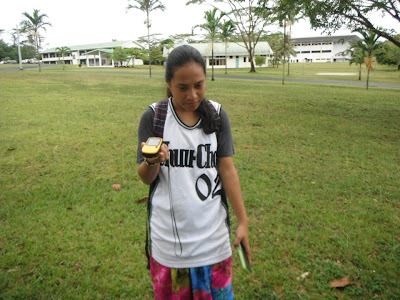Speed of sound
The speed of sound laboratory began with steady rain. By 9:00 the rain had eased to a light enough rain to be able to hear an echo. The eight o'clock section then ventured out to find sheltered echo launch locations from which to make measurements.
The extra time provided an opportunity to cover the speed of sound in detail including an analysis of how far sound can travel within the span of human reaction times. During the fastest double click of the stop watch, 0.09 seconds, sound travels 31.5 meters - the length of the A building.
The dry bulb temperature at 8:00 was 25 Celsius, the wet bulb was 25 Celsius, thus the wet bulb depression was 0 Celsius. The humidity was 100%. There was fog on the ridge and rain in the air, little wonder that the humidity was saturated humidity.
The rain also permitted coverage of how the laboratory works and a short primer on significant digit
The long echo to the women's dormitory. Tough to time at the distance.
The students sat this one out while I stood in the light rain and clapped.
The core gear for the laboratory.
Reliann and Darla study the data gathered.
Darby walking back from the bookstore.
Person has a go at clapping.
Darby returns.
The extra time provided an opportunity to cover the speed of sound in detail including an analysis of how far sound can travel within the span of human reaction times. During the fastest double click of the stop watch, 0.09 seconds, sound travels 31.5 meters - the length of the A building.
The dry bulb temperature at 8:00 was 25 Celsius, the wet bulb was 25 Celsius, thus the wet bulb depression was 0 Celsius. The humidity was 100%. There was fog on the ridge and rain in the air, little wonder that the humidity was saturated humidity.
The rain also permitted coverage of how the laboratory works and a short primer on significant digit
The long echo to the women's dormitory. Tough to time at the distance.
The students sat this one out while I stood in the light rain and clapped.
The core gear for the laboratory.
The class gathered under the eave of the administration building. I would spend the day wet due to two outdoor laboratories and a forest hike in ethnobotany, I felt there was little educational value in having the students also wet all day.
Darla clapped for echoes off of the cafeteria.
Reliann and Darla study the data gathered.
As I often do for laboratory nine, I sketched out the xy scattergraph and ran a preliminary best fit line to determine whether the y-intercept might prove problematic. Laboratory nine really benefits from the use of the LINEST function with the y-intercept set to zero. LINEST was dropped from the fourth edition of the text. The students could not determine when to use SLOPE, INTERCEPT, and when to use LINEST. My statistics alumni were also confused as they had not used LINEST. Still, LINEST often produces a smaller error against the expected value than SLOPE>
Darby walking back from the bookstore.
Person has a go at clapping.
Darby returns.















Comments
Post a Comment